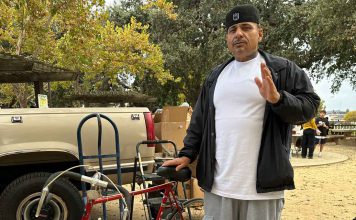A dozen binders line an investigations desks at the Gilroy
Police Department. Each binder signifies a Gilroy murder that’s
gone cold, a family left grasping for closure, a killer that hasn’t
been brought to justice.
A dozen binders line an investigations desks at the Gilroy Police Department. Each binder signifies a Gilroy murder that’s gone cold, a family left grasping for closure, a killer that hasn’t been brought to justice.
Though one case dates back more than 30 years, Gilroy has seen four unsolved killings in the last three years alone. Two have gone cold – “all the evidence has gone out and come back with no hits, no calls coming in,” said Homicide Detective Stan Devlin – while two remain active, albeit slow-moving. The term “cold case” is reserved for those that turn up no leads after all sources have been tapped, all evidence processed.
Why a case goes cold
Although there’s no set time frame that dictates when a case goes cold, a few telltale signs indicate that a case is heading in that direction.
“A case goes cold when nothing comes in at all,” said Detective Jason Smith, who is investigating the shooting death of Andres Cebreros, a man who was killed at the Aloha Club in April 2009.
No evidence and no witnesses mean no suspects, said Devlin, who has been with the Gilroy Police Department since 1995. He is in his fourth year as Gilroy’s homicide detective.
When the fingerprints or DNA collected at a crime scene don’t turn up a match, investigators rely on witness statements. But in gang-related cases especially, such as the confrontation between two rival gangs that lead to a fatal drive-by shooting on Farrell Avenue in September 2008, witnesses are loath to talk. A similar and possibly related homicide took the life of 18-year-old Larry Martinez a few months after the Farrell Avenue shooting, but with a very different outcome. The suspects police believe are responsible for the Martinez murder are currently awaiting trial. Meanwhile, Lopez’s murderer is still at large.
“In the Martinez case, if we took the civilian witnesses out of the picture, we might be in the same situation as the (Lopez) case,” Devlin said. “They’re the ones that come forward and put the case in motion.”
When gang members are shown photo lineups or asked for information, even if they were the victims of crime, “They strangely don’t know anything,” Devlin said.
Fresh eyes on a case
With a newly elected Santa Clara County District Attorney promising to reinstate the office’s cold case unit when he takes the county’s prosecutorial reins in January, Devlin said he’s hopeful that a fresh set of eyes will yield new leads. Bringing back the cold case unit was a linchpin of Jeff Rosen’s campaign. He said he’d like to appoint at least one full-time investigator to the unit to assist police agencies with their unsolved murders.
“There’s a reason there’s no statute of limitations on murder,” Rosen said. “There’s a saying that if you save one person, it’s like you’ve saved a whole world. Well, it’s the same if you kill someone. You kill a whole world. Everyone’s life is of infinite value in my opinion.”
Though some cases are stubborn, persistence pays off and Rosen said he hopes the unit can put a significant dent in the number of cold cases countywide.
“From a practical perspective, it’s important to the community not to have murderers walking amongst us,” Rosen said. But after years of working with families who have lost loved ones to murder, “It’s also important for them to know that there’s some justice. It means a great deal to those families to know that they’re not forgotten.”
Though affected to a lesser extent, community members said they’re still uneasy when murders that have taken place practically in their own front yards have gone unsolved.
“Their father doesn’t let these kids out of his sight,” said Shirley Rose, the grandmother of three young girls who live on Farrell Avenue.
After the Lopez murder, “We haven’t heard much since,” said another Farrell resident, adding that she hopes the attitude isn’t “out of sight, out of mind.”
“The more exposure, the more likely it is that something will come to light,” said Josie Bravo, a lifelong Gilroy resident. “It’s not the safest place but we’re comfortable because we’ve been here so long.”
Hoping for a hit
Although investigators might strike out time after time with some crimes, a nationwide bank of evidence – fingerprints, DNA, weapons – means that police can receive a hit on a case years after it seems to have gone cold. Any DNA or fingerprints taken from an incoming arrestee is entered into the system. With new information being entered every day, the list is building. And sometimes, there’s a match between a new sample of DNA and an identified sample previously collected at a crime scene, Devlin said.
The inability of some people to keep a secret is another certainty police can count on.
“All these murderers have to have told someone,” Devlin said. “Someone else other than the murderer has to know that they whacked Mr. Lugo or Mr. Lopez, and all of a sudden, one day, they’re going to want to relieve themselves of that knowledge.”
Often, that person is the wife or girlfriend of the murderer, Devlin learned in a seminar he took on solving cold cases.
“The best way to get a cold case back is when a jilted lover comes forward,” Devlin said. “I’m serious. The female finally snaps and calls us.”
Other times, as the culprit ages, he or she “gets tired of carrying the burden of the crime within and wants to cleanse himself before meeting his maker,” Devlin said.
Still, whether police are able to collect cold, hard evidence or apprehend a suspect soon after the crime takes place are the best indicators of how a case will go.
But until some new piece of evidence surfaces, all Devlin can do is cross his fingers and hope for a spurned lover.














